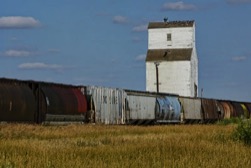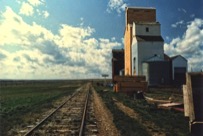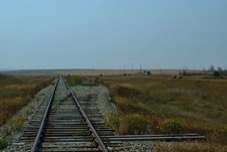
A vator is....
Vator /veItƏ/ ●n. a self-coined term for a tall building used for storing grain; a.k.a. a 'grain elevator'. ●v. to actively look for grain storage buildings (e.g. to vator, to go vatoring.)
The Elevator-ologist's story...
I saw my first grain elevator on a visit to the Prairies in the early 1980s in the town of Harptree, Saskatchewan (SE22-04-26-W2 ). The town had a population of four; one family. Twenty years later, when I had taken up residence in Saskatchewan, I returned to Harptree. The town was gone; the vators, the family home were gone, demolished in September 1997. This obliteration included the 120,000 bushel wood-crib vator I had seen under construction in 1982.
If after only fifteen short years, a vator built to last forty years, was being abandoned and subsequently demolished, then other, older ones, within the province, and the prairies in general, would soon meet their demise. So began the quest to capture these remaining prairie giants on film and to collect information on these icons.
- The ‘Grain Elevatorologist’ or ‘Vatorologist’ was created.
After four years of living on the Canadian Prairies, 2003-2007, I have photographed nearly all the remaining vators still standing in Western Canada. Following that, four years of residence in Eastern Ontario afforded me the opportunity to visit several Ontario, Quebec and Maritime sites. From 2011-2015 I took up residence in Colorado and toured the American Plains. Now, back in Western Canada, it is time to revisit old sites and research new ones. The process is long and the wrecker keeps robbing us of this heritage. The weather also plays its role; however, a bad, cloudy day shot of a vator is better than never getting the shot at all.
My catalogue numbers over 3500 sites as I strive to place sample images in the attached galleries.




Gravelbourg, SK August 2004
Harptree, SK August 2003
Harptree, SK May 1982